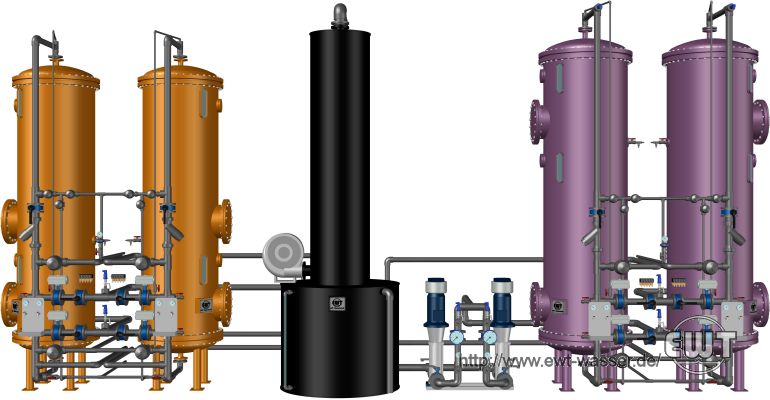

← Home • Products • Demineralisation ↓ Summary • Design Example • Applications • Technical Data • Downloads
Demineralisation (also: demineralization) is both a generic term for processes for removal of dissolved solids from water, and a specific term for certain →ion exchange processes for that same purpose.
An ion exchange demineralisation plant (short: IX demin plant) involves at least two subsequent process steps: cation exchange, and anion exchange, also as a possible further polishing step →mixed bed ion exchange. During cation exchange, cations dissolved in the water are exchanged for hydrogen ions (H+). During anion exchange, anions dissolved in the water are exchanged for hydroxide ions (OH-). Hydrogen ions and hydroxide ions react to water. The cation exchange and the subsequent anion exchange occur different vessels, each filled with a different kind of ion exchange resins.
The treated water is called deionised water or demineralised water (short: demin water). With increasing service life, the ion exchange resins deplete. Depleted ion exchange resins are regenerated, usually with hydrochloric acid (HCl) and sodium hydroxide (NaOH). With each regeneration, potentially acidic or alkaline waste water is produced, which may need to be neutralised.

Ion exchange demineralisation plant, two lines, packed bed process with upflow service, counter-flow regeneration, fully automated, process sequence: cation exchanger weak/strong acid, CO2-degasser, anion exchanger weak/strong base.
| demin water volume flow |
available from approx. 0.5 up to 350 m³/h for each line condensate demineralisation from approx. 1.5 up to 550 m³/h for each line |
||
| amount of lines | usually 2x100% | ||
| demin water quality | electrical conductivity |
0.2 ... 5μS/cm, counter-flow regeneration 2 ... 20 μS/cm, co-flow regeneration |
|
| silicic acid |
0.02 ... 0.05 mg/L SiO2, counter-flow regeneration 0.1 ... 0.2 mg/L SiO2, co-flow regeneration |
||
| differential pressure at nominal flow | usually approx. 1.0 ... 1.5 bar for each process step | ||
| operating temperature |
usually 10 ... 30 °C condensate demineralisation ≤ 60 °C |
||
| regeneration agent |
usually hydrochloric acid (HCl) for cation exchanger usually sodium hydroxide (NaOH) for anion exchanger |
||
| regeneration intervals |
usually 6 ... 24 h condensate demineralisation often ≥ 24 h |
||
| regeneration duration | approx. 120 ... 180 minutes | ||
| chemical consumption |
approx. 50 ... 100 g HCl and 25 ... 180 g NaOH for each 1 mol NaCl, counter-flow regeneration (¹) approx. 60 ... 120 g HCl and 30 ... 200 g NaOH for each 1 mol NaCl, co-flow regeneration (¹) |
||
| regeneration effluent |
approx. 3.5 ... 15 L for each 1 mol NaCl, counter-flow regeneration (¹) approx. 10 ... 30 L for each 1 mol NaCL, co-flow regeneration (¹) |
||
| recommended raw water quality | suspended solids |
< 0.5 ... 1 mg/L, counter-flow regeneration < 1 ... 5 mg/L, co-flow regeneration |
|
| free chlorine | < 0.1 mg/L Cl2 | ||
| total organic carbon (TOC) | ≤ 1 ... 5 mg/L C | ||
| oil, grease | < 0.1 mg/L | ||
| ion exchange media |
• cation exchange resin, weak acid, polyacryloc • cation exchange resin, strong acid, gelförmig, polyacrylic • cation exchange resin, strong acid, makroporös, polyacrylic • anion exchange resin, weak base, polystyrenic • anion exchange resin, weak base, polyacrylic • anion exchange resin, strong base, type I, gel, polystyrenic • anion exchange resin, strong base, type II, gel, polystyrenic • anion exchange resin, strong base, type I, macroporous, polystyrenic • anion exchange resin, strong base, type II, macroporous, polystyrenic • ... |
||
| total service life of the ion exchange resins |
usually ≥ 10 years for cation exchange resins usually approx. 5 ... 10 years for anion exchange resins |
||
| material options | pressure vessels |
• glass-reinforced plastic (GRP) • carbon steel (e.g. S235JR, P265GH) • stainless steel (e.g. 1.4404, 1.4571) |
|
| pipelines |
• polyvinyl chloride (PVC) • polypropylene (PP) • polyvinylidene fluoride (PVDF) • stainless steel (e.g. 1.4404, 1.4571) |
||
| valves |
• polyvinyl chloride (PVC) • polypropylene (PP) • polyvinylidene fluoride (PVDF) • stainless steel (e.g. 1.4408) |
||
| gaskets |
• ehtylene propylene diene monomer rubber (EPDM) • fluoroelastomer (FKM) • polytetrafluoroethylene (PTFE) |
||
| control options | regeneration, line change-over |
• fully automated, via micro-processor control unit • vollautomatisch, via PLC • manual operation (usually not recommended) |
|
| process monitoring |
• volume counter (standard) • differential pressure (standard) • elecrical conductivity (standard) • silicic acid (option) • total organic carbon (TOC) (option) |
||
| ¹ Chemical equivalent relations: 1 mol NaCl = 1 eq = 50 g CaCO3, see →unit conversions. Example: In case of raw water with total dissolved solids (TDS) equal to 4 meq/L, counter-flow regeneration, and a volume flow of 10 m³/h, the mean chemical consumption is 4 mol/m³ ⋅ 10 m³/h ⋅ 50 ... 100 g HCl = 2 ... 4 kg/h HCl and 4 mol/m³ ⋅ 10 m³/h ⋅ 25 ... 180 g NaOH = 1 ... 7.2 kg/h NaOH, while the mean effluent discharge is 4 mol/m³ ⋅ 3.5 ... 10 m³/h ⋅ 15 L = 140 ... 600 L/h. | |||
–
2018-05-05 • water treatment made in Germany • Company Information • Privacy